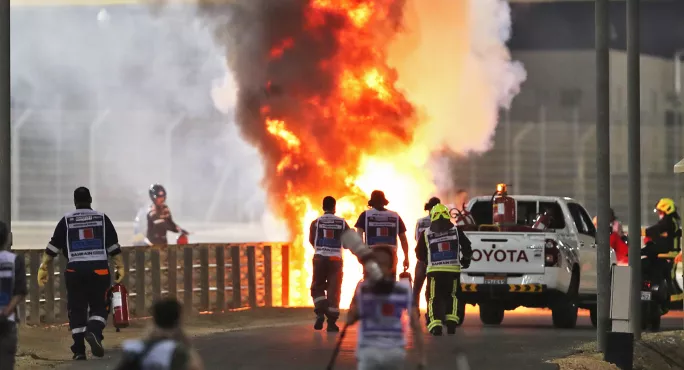Do we value sportspeople more than teachers?

As the NHS begins administering the first phase of the Covid vaccination programme to the most vulnerable - with a 90-year-old woman today becoming the first person in the world to receive the Pfizer vaccine outside a clinical trial - teachers are still hoping that we might be included in the second phase, in a few months’ time.
But this doesn’t solve the immediate problem of teachers’ safety in the classroom. The Christmas holidays aren’t far away, but the government is remaining adamant in its refusal to allow schools to either shift to home-guided learning or to break up early.
Meanwhile, I was horrified to read about the severity of the accident at the Bahrain Grand Prix circuit last week, and heartened by the narrow escape of racing driver Romain Grosjean. He hit the steel barrier with such force that his car was sliced in two and burst into flames.
As fans of Formula 1 will know, back in the 1960s and 1970s the sport had an excessive death toll, with few really effective safety measures in place. This has since changed, quite significantly.
Coronavirus: Where’s the safety system for teachers?
The account of Grosjean’s post-accident escape shows how much he owes to significant investment in a fireproof suit and cockpit safety measures, as well as to the swift action of everyone who dragged him out of his car and into a safety vehicle. The halo system - a safety bar stretching around the cockpit area - saved his life.
In motorsport, life-threatening accidents are now relatively rare, but no expense is spared in setting up life-saving precautions. What Grosjean’s escape shows is how much the lives and skills of Formula 1 drivers are valued.
Even in lower-level motorsports, there are advances in safety. Not only do speedway meetings at all levels have an ambulance on site for the duration of the meeting, but there are new air fences to absorb impact and ensure that, when the riders run out of skill (or luck), their injuries are less severe.
If only there were the same attitude to the safety of teachers, who work every day in overcrowded classrooms across the country in the pandemic.
In extreme sports, the dangers are spectacular and immediate. In classrooms, the danger is a creeping and invisible one.
The difference between bubbles and halos
Teachers are not clad in the equivalent of fireproof suits, nor are they supplied with more than - at best - a flimsy visor or face mask. They certainly don’t have anything resembling a halo system. The cost of a screen around a teacher would be rather high on the very limited budgets that schools receive at any time, let alone during a pandemic.
Formula 1 tracks have been modified at great expense. But decades of under-investment in classrooms have resulted in overcrowding and poor working conditions. The possible spacing between desks to maintain appropriate social distancing is very limited.
Although they sound equally light and delicate, there is a huge difference between a “bubble” and a halo. The former is easily burst. The latter is not just rigid and expensive, it’s also been through trials and rigorous testing. Who can say the same of the bubbles in schools across the country?
Even as recently as 13 November, a letter from the SAGE committee of scientists to the NEU teaching union confirmed that the Office for National Statistics and SAGE were intending to start collecting data on school bubbles and ventilation. But why hadn’t they done this long before?
It must by now be obvious, from the millions invested in making their races safer, how much the lives of grand prix drivers are valued. Perhaps it’s because the sport is sufficiently rich to be able to afford such safety.
The callous refusal to keep up-to-date statistics
Obviously, it’s too much to expect in the short or even long term that a country facing a pandemic-induced economic crisis will invest in better safety measures to keep teachers and pupils safe.
But that does not excuse the callous and casual refusal to keep up-to-date statistics of infection, hospitalisation and mortality rates for teachers. In motorsport, the casualty lists are kept and the safety record updated.
All this goes to show the huge difference between the value of sportsmen’s lives in a high-risk sport (where the dangers are present for a short period of time on track), and the cost of the long-term safety of the occupants of the nation’s classrooms.
But, while teachers’ lives are considered expendable, the service they offer day in, day out is incalculable. From our efforts come the professionals and key workers of the future: the doctors, nurses, care workers, lawyers, bankers, business people and all strata of society in between.
Maintaining education in the classroom to improve the life chances of the cohorts of the 2020s is surely of paramount importance for the long-term good of the country. It’s profligate not to take more stringent measures to reduce infection rates.
Such a casual attitude would not be tolerated in motor racing. Drivers are irreplaceable.
So are teachers.
Yvonne Williams is head of English and drama in a secondary school in the South of England. She has contributed chapters on workload and wellbeing to Mentoring English Teachers in the Secondary School, edited by Debbie Hickman (Routledge)
You need a Tes subscription to read this article
Subscribe now to read this article and get other subscriber-only content:
- Unlimited access to all Tes magazine content
- Exclusive subscriber-only stories
- Award-winning email newsletters
Already a subscriber? Log in
You need a subscription to read this article
Subscribe now to read this article and get other subscriber-only content, including:
- Unlimited access to all Tes magazine content
- Exclusive subscriber-only stories
- Award-winning email newsletters